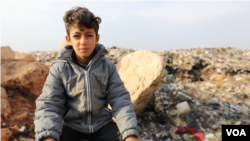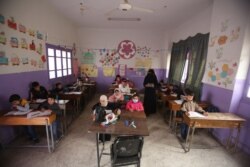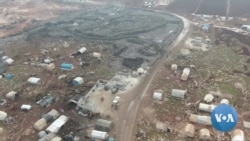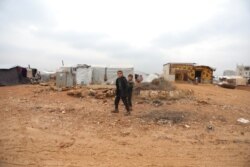As the truck pulls into the landfill, women and children crowd around, pouncing at the pile of trash as it is dumped onto the field of gray garbage.
After the most valuable items are collected, small groups of children remain, picking through the heaps, looking for plastic bottles and bags, soda cans or bits of metal.
They make less than a dollar a day selling the trash, but it allows their families to eat. Resting on some rocks in the dump, Hassan Alhamdi, 12, says he used to go to school and once had dreams of growing up to be a teacher. But now he seems proud to be able to provide.
“I collect plastic bags for work,” he says. “I leave in the morning and come back at night. I bring food and bread for my siblings.”
Alhamdi, his parents, and his seven brothers and sisters fled their homes here in Idlib province more than a year ago, as nearly a million people were displaced from the fighting. Now he and his seven siblings all work every day of the week, and none of them go to school.
Their parents say it is heartbreaking to watch their children grow up without education, but they see no other option. Aid organizations and governments have abandoned them, says Mahdiye Alhamad, the mother, and amid the harsh winter, the war and the coronavirus pandemic, they are barely surviving as it is.
“These jobs will impact everything about their future,” she says. “They don’t even know how to write.”
Out of school
Ali, Hassan Alhamdi’s 11-year-old brother, is less sanguine about his long days of work, saying he dreams of having a bicycle, a football and an education. But for now, he says, he is mostly just tired.
"I wish I could go to school,” he adds, shrugging. “It would be better. But we are working.”
About 2 million other displaced children inside Syria also are out of school, according to Human Rights Watch. Outside the country, nearly a million Syrian refugee children are also not attending classes.
And this number is growing by the millions worldwide, adds UNICEF, with more and more children being pushed into the workforce as poverty deepens because of the pandemic. The longer children remain out of school, the organization says, the less likely they are to have the chance to return.
Nongovernmental organizations have set up some schools in this area, but administrators say that many children who do attend come in late or leave early for their jobs.
“Everything in our society has changed from the war,” says Muzn Naes, a school manager. “Some students work because their families are poor. Others have parents that were killed or wounded.”
Besides missing their education, children are in danger of getting injured or exploited at work, says Naes. It puts the future of the region at grave risk in the long term, and in the short term it is already draining the crumbling economy.
“Child labor affects everything in society,” she explains in a classroom decorated with purple paint and colorful hand-drawn language lessons. “And when it increases, so does unemployment. Employers hire children for low pay, replacing adults.”
Last stronghold
For most of Syria, the 10-year-old war is winding down, with the government of President Bashar al-Assad as the clear victor.
But Idlib is the last remaining opposition stronghold, and the 1.5 million displaced people here are isolated and trapped between the warring parties, which continue fighting sporadically.
Renewed all-out war could deepen the crisis, pitting Turkey and Syria directly against each other in the battlefield. And for families, the current quagmire also is increasingly dangerous as they try to survive amid soaring food prices, harsh winter weather and the pandemic.
After a day in the landfill, brothers Hassan and Ali Alhamdi carry large bags across the street, meeting men who have set up a scale. They weigh the boys’ haul, and pay them each four to five Turkish lira, about 65 cents.
The nearby landfill is vast, but it’s not enough to support them and the other families selling recyclables. Increasingly, the boys have to walk farther and farther from home to find enough garbage to sell.m getting so tired, but what can I do?” says Hassan Alhamdi. “This is our situation. We are displaced and we have to work to feed ourselves.”
Shadi Turk, Mohamad Daaboul and Fateh Raslan contributed to this report.
















